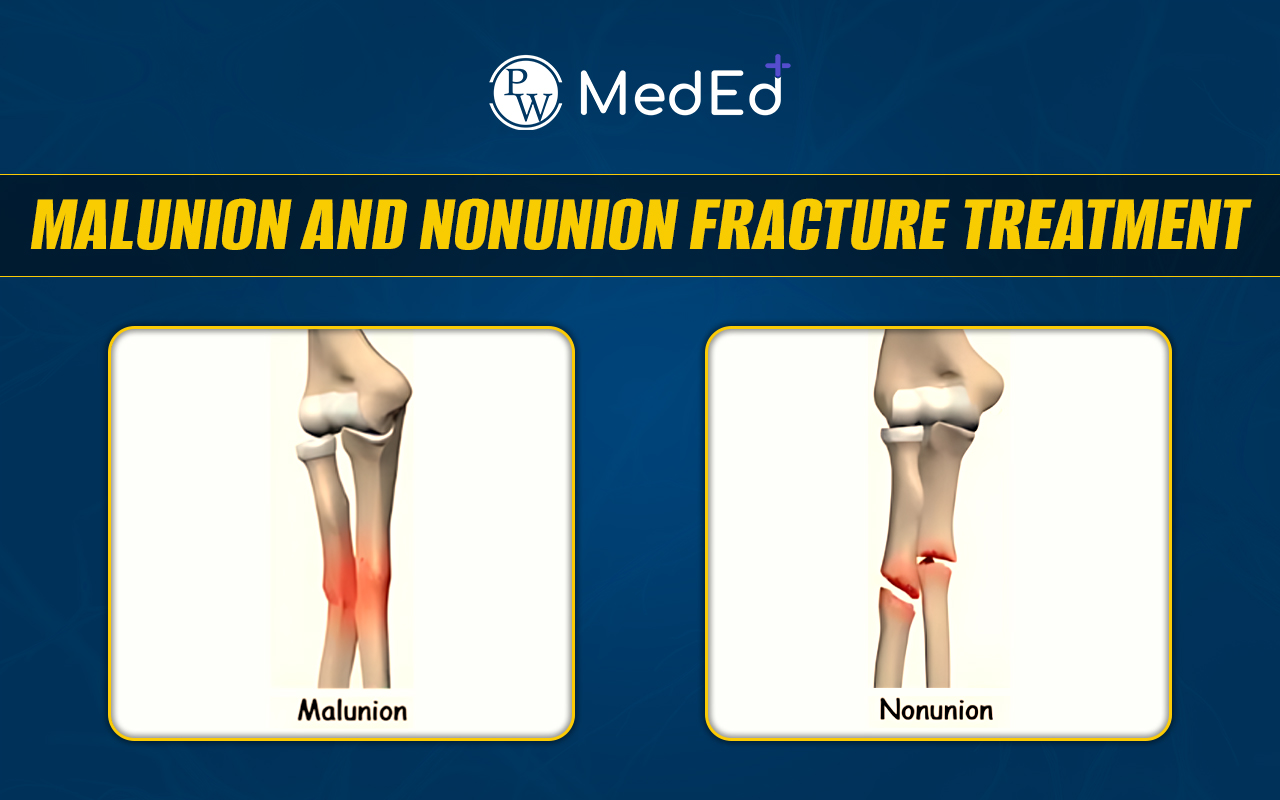

Malunion and Nonunion: Complications of Bone healing. Bone fractures are common injuries that often heal well with proper treatment. However, complications can sometimes arise during the healing process. Two of these complications are malunion and nonunion, both of which can affect the normal function of the affected bone. These conditions can lead to significant challenges, including pain and difficulty in movement. Understanding these issues is key to addressing them effectively.
For better and detailed information about this topic you can refer to the PW Med Ed App clinical corner. Its user-friendly interface, regular updates, and evidence-based content make it a reliable companion for exam preparation, ward rounds, or simply brushing up on medical concepts. It provides an exceptional blend of high-yield content, clinical pearls, and practical guidance tailored to students.Visit – MedEd App
Malunion
Malunion occurs when a fractured bone heals, but in the wrong position. This misalignment can lead to the bone being crooked, shortened, or rotated improperly. For example, a broken arm bone may heal at an angle, causing difficulty in using the arm as before. Malunion can result in deformities, reduced mobility, and discomfort, depending on the severity of the misalignment and the location of the fracture.Read More - Pharyngeal Arches
Nonunion
Nonunion refers to a fracture that fails to heal altogether. In this condition, the broken ends of the bone do not come together even after several months of treatment. Nonunion can lead to ongoing pain, instability in the affected area, and an inability to perform normal activities. It is more common in complex fractures or when certain risk factors are present, such as poor blood flow to the bone. Both malunion and nonunion can occur for various reasons. Inadequate immobilization of the fracture, where the bone is not held in place firmly enough during healing, is a common cause. Poor nutrition, smoking, and conditions like diabetes or osteoporosis can also hinder the bone’s ability to heal properly. Infections at the fracture site, which interfere with the healing process, are another significant risk factor for nonunion.Symptoms of Malunion and Nonunion
The symptoms of malunion and nonunion often overlap, but there are key differences. In malunion, the bone’s abnormal shape can cause visible deformity, pain during movement, or difficulty using the affected limb. For nonunion, the main signs are persistent pain, swelling, and instability at the fracture site. In both cases, imaging studies like X-rays or CT scans are usually required to confirm the diagnosis and determine the extent of the problem.Read More - Radiodiagnosis
Treatment Modalities
Treatment for malunion and nonunion varies based on the severity and location of the fracture, as well as the patient’s overall health. For malunion, surgery is often needed to correct the misalignment. This procedure, known as an osteotomy, involves cutting and realigning the bone, followed by stabilizing it with plates, screws, or rods. The goal is to restore the bone’s proper shape and function. Nonunion typically requires more advanced treatment strategies. In many cases, surgery is necessary to stimulate healing. Bone grafting, where healthy bone tissue is taken from another part of the body or a donor, is a common procedure. This graft provides a framework for new bone growth and helps bridge the gap between the broken ends. Sometimes, special devices like external fixators or bone stimulators that use electrical currents or ultrasound are used to encourage healing.Prevention and Rehabilitation
Preventing malunion and nonunion begins with proper fracture management. Early and accurate diagnosis, along with appropriate treatment, is critical. This includes immobilizing the fracture with a cast, splint, or surgical fixation to ensure the bones are held in the correct position. Maintaining a healthy lifestyle is also important; quitting smoking, eating a balanced diet rich in calcium and vitamin D, and managing any chronic health conditions can improve the chances of successful healing. Living with malunion or nonunion can be challenging, but with the right care, most patients can regain mobility and reduce discomfort. If you suspect that a fracture is not healing properly or is causing significant pain, it’s important to seek medical advice promptly. Early intervention can prevent complications and improve outcomes.Sports Injuries FAQs
What is a Thomas Splint?
A Thomas splint is a medical device used to stabilize and immobilize a fractured limb, especially in the thigh or femur. It consists of a metal frame that supports the limb, helping to reduce pain, prevent further damage, and allow proper alignment for healing.
How does Vitamin D help in bone growth?
Vitamin D plays a crucial role in bone growth by helping the body absorb calcium and phosphorus from food. These minerals are essential for building and maintaining strong bones.
What is the ideal time frame in which to visit a doctor after a fracture?
You should visit a doctor immediately after a fracture or suspected fracture. Early diagnosis and treatment are critical to ensure proper alignment, reduce pain, and prevent complications such as malunion, nonunion, or infection.
How do infections at the fracture site prevent union?
Infections at the fracture site disrupt the healing process by causing inflammation, reducing blood supply to the area, and destroying new bone tissue. Bacteria can form a biofilm on the bone, making it harder for the body to fight the infection and for the bone to heal properly.
Talk to a counsellorHave doubts? Our support team will be happy to assist you!

Check out these Related Articles
Free Learning Resources
PW Books
Notes (Class 10-12)
PW Study Materials
Notes (Class 6-9)
Ncert Solutions
Govt Exams
Class 6th to 12th Online Courses
Govt Job Exams Courses
UPSC Coaching
Defence Exam Coaching
Gate Exam Coaching
Other Exams
Know about Physics Wallah
Physics Wallah is an Indian edtech platform that provides accessible & comprehensive learning experiences to students from Class 6th to postgraduate level. We also provide extensive NCERT solutions, sample paper, NEET, JEE Mains, BITSAT previous year papers & more such resources to students. Physics Wallah also caters to over 3.5 million registered students and over 78 lakh+ Youtube subscribers with 4.8 rating on its app.
We Stand Out because
We provide students with intensive courses with India’s qualified & experienced faculties & mentors. PW strives to make the learning experience comprehensive and accessible for students of all sections of society. We believe in empowering every single student who couldn't dream of a good career in engineering and medical field earlier.
Our Key Focus Areas
Physics Wallah's main focus is to make the learning experience as economical as possible for all students. With our affordable courses like Lakshya, Udaan and Arjuna and many others, we have been able to provide a platform for lakhs of aspirants. From providing Chemistry, Maths, Physics formula to giving e-books of eminent authors like RD Sharma, RS Aggarwal and Lakhmir Singh, PW focuses on every single student's need for preparation.
What Makes Us Different
Physics Wallah strives to develop a comprehensive pedagogical structure for students, where they get a state-of-the-art learning experience with study material and resources. Apart from catering students preparing for JEE Mains and NEET, PW also provides study material for each state board like Uttar Pradesh, Bihar, and others
Copyright © 2025 Physicswallah Limited All rights reserved.
Get App










